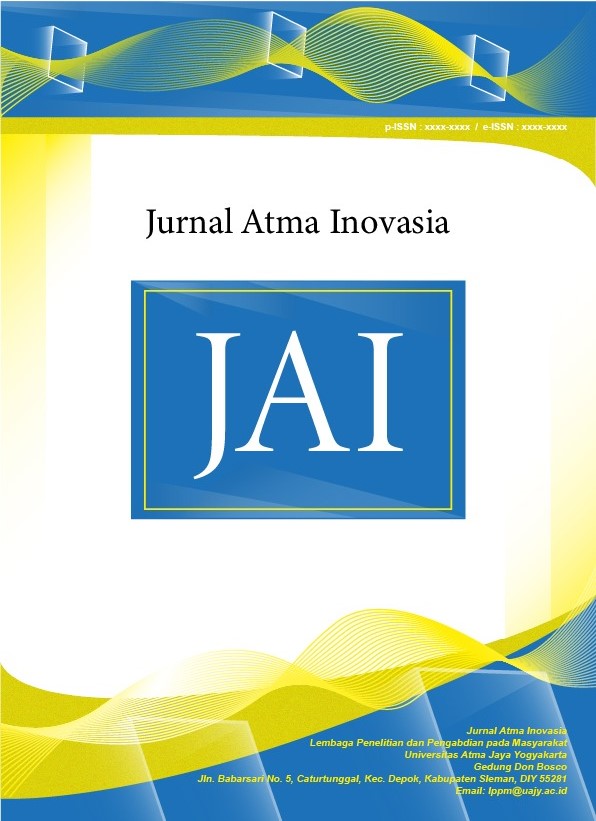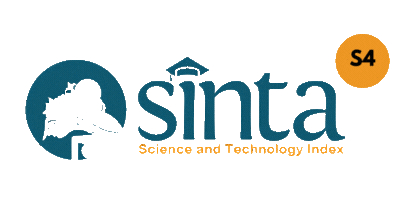Pengabdian Masyarakat Dokumentasi Rumah Vernakular di Kawasan Candi Borobudur
DOI:
https://doi.org/10.24002/jai.v5i2.10594Keywords:
arsitektur vernakular, pelestarian warisan budaya dunia, kolaborasi, borobudur, dokumentasi digitalAbstract
Kawasan Candi Borobudur (KCB) merupakan situs Warisan Budaya Dunia (WBD) dengan signifikasi yang tinggi. Program pengabdian masyarakat ini menerapkan pendekatan kolaboratif antara akademisi, UNESCO, Pusat Dokumentasi Arsitektur (PDA), Eksotika Desa, pemerintah, dan warga setempat. Artikel ini mendeskripsikan proses kegiatan pengabdian masyarakat untuk mendokumentasi elemen arsitektur rumah vernakular di Kawasan Candi Borobudur (KCB). Program pengabdian ini menekankan pentingnya keterlibatan multi-sektor dalam proses pendokumentasian kekayaan budaya, salah satunya pada aspek arsitektur vernakular dengan mengintegrasikan kegiatan pembelajaran dengan kerja sama LSM, dinas terkait, dan masyarakat. Luaran pengabdian yang diharapkan adalah dokumentasi digital (model 3D SketchUp dan foto panorama 360o) dan infografis, dengan tujuan memperkaya data digital arsitektur vernakular, mendukung keberlanjutan nilai-nilai budaya di kawasan tersebut, dan memperluas audiens dalam memahami arsitektur vernakular di KCB. Artikel ini mendeskripsikan tahapan dokumentasi arsitektur vernakular yang efektif dan berkelanjutan sebagai bagian integral dari identitas budaya dan sejarah Candi Borobudur.
References
[1] UNESCO, “Borobudur Temple Compounds,” 2024. https://whc.unesco.org/en/list/592/.
[2] UNESCO, “Operational Guidelines for the Implementation of the World Heritage Convention,” 2023. doi: 10.34685/hi.2022.25.22.001.
[3] Kementerian PUPR, “Integrated Tourism Master Plan Borobudur-Yogyakarta-Prambanan (Itmp-Byp),” pp. 1–350, 2020.
[4] K. Khaerunnisa, M. Cininta, and Y. D. Handarkho, “Peningkatan Partisipasi Relawan dan Pelaku Pariwisata dalam Pengelolaan Risiko Bencana di Kompleks Candi Borobudur,” J. Atma Inovasia, vol. 2, no. 1, pp. 20–25, 2022, doi: 10.24002/jai.v2i1.5398.
[5] T. Z. Karim, H. Siregar, S. Mulatsih, and B. Tjahjono, “International Journal of Sustainable Development and Planning Analysis of Priority Tourism Objects and Impact of the Tourism Development of Disaster- Prone Areas in Morotai Island Regency,” vol. 19, no. 11, pp. 4421–4429, 2024.
[6] A. C. Flyen, C. Flyen, and A. W. Hegnes, “Exploring Vulnerability Indicators: Tourist Impact on Cultural Heritage Sites in High Arctic Svalbard,” Heritage, vol. 6, no. 12, pp. 7706–7726, Dec. 2023, doi: 10.3390/heritage6120405.
[7] D. H. Rahmi, H. . Sudibyakto, H. Sutikno, and L. T. Adishakti, “Pusaka Saujana Borobudur: Perubahan dan Kontinuitasnya,” J. Mns. dan Lingkung., vol. 19, no. 1, pp. 85–94, 2012, [Online]. Available: https://jurnal.ugm.ac.id/JML/article/view/18456/11749.
[8] A. Swastikawati, “Pengelolaan konflik pendirian menara BTS (Base Transceiver Station) di kawasan Borobudur,” Universitas Gadjah Mada, 2010.
[9] C. A. M. da C. de Araújo, “ASSESSING THE IMPACT OF THE JIWA JAGAD JAWI VIDEO ON INDONESIAN CULTURAL AWARENESS,” in THE 3RD INTERNATIONAL CONFERENCE ON ECONOMICS, BUSINESS, AND MANAGEMENT RESEARCH (ICEBMR), 2024, vol. 3, [Online]. Available: https://e-conf.usd.ac.id/index.php/icebmr/icebmr2024/paper/viewFile/3748/661.
[10] D. J. Wibowo, “ANALISIS HUKUM KEWENANGAN WORLD HERITAGE COMMITTEE SEBAGAI KOMITE CONVENTION CONCERNING THE PROTECTION OF THE WORLD CULTURAL AND NATURAL HERITAGE DALAM PENGHENTIAN PEMBANGUNAN FASILITAS PARIWISATA DI KOMPLEK CANDI BOROBUDUR,” Universitas Surabaya, 2023.
[11] A. A. Prakoso and N. Irawati, “Adaptasi Elemen Ruang Pedesaan Terhadap Kegiatan Pariwisata Di Kawasan Borobudur,” Aksen J. Des. Creat. Ind., vol. 7, no. 1, pp. 1–25, 2022, doi: 10.37715/aksen.v7i1.2668.
[12] D. H. Rahmi, “The Cultural Landscape of Borobudur: Borobudur Villages – Continuity and Change,” in Borobudur as Cultural Landscape: Local Community Initiatives for the Evolutive Conservation of Pusaka Saujana Borobudur, K. Kanki, L. Adishakti, and T. Fatimah, Eds. Kyoto University Press, 2015.
[13] L. T. Adhisakti et al., Arsitektur Vernakular Borobudur, 1st ed. Kementerian Pendidikan, Kebudayaan, Riset dan Teknologi, 2024.
[14] S. Dutta and N. Kumar, “A Comprehensive Understanding of the Research Themes, Trends and Future Directions of Vernacular Architecture Using Bibliometric Analysis,” Lect. Notes Civ. Eng., vol. 527 LNCE, pp. 591–614, 2025, doi: 10.1007/978-981-97-4988-1_34.
[15] I. Rajković, M. Bojović, D. Tomanović, and L. C. Akšamija, “Sustainable Development of Vernacular Residential Architecture: A Case Study of the Karuč Settlement in the Skadar Lake Region of Montenegro,” Sustain., vol. 14, no. 16, 2022, doi: 10.3390/su14169956.
[16] A. Formolly and M. H. Saraei, “Socio-cultural transformations in modernity and household patterns: a study on local traditions housing and the impact and evolution of vernacular architecture in Yazd, Iran,” City, Territ. Archit., vol. 11, no. 1, Dec. 2024, doi: 10.1186/s40410-024-00236-6.
[17] N. Yang, J. Chen, L. Ban, P. Li, and H. Wang, “Pre-Planning and Post-Evaluation Approaches to Sustainable Vernacular Architectural Practice: A Research-by-Design Study to Building Renovation in Shangri-La’s Shanpian House, China,” Sustain., vol. 16, no. 21, Nov. 2024, doi: 10.3390/su16219568.
[18] G. Weichart, “Javanese Architecture between Heritage and Mobility,” Fabrications, vol. 30, no. 1, pp. 25–43, 2020, doi: 10.1080/10331867.2020.1726626.
[19] N. T. Nam and N. N. Thanh, “The role of local communities in the conservation of cultural heritage sites: A case study of Vietnam,” J. Asian Sci. Res., vol. 14, no. 2, pp. 179–196, 2024, doi: 10.55493/5003.V14I2.5057.
[20] D. H. Rahmi and S. Tamimi, “Traditional Domestic Architecture in the Rural Cultural Landscape of Borobudur, Indonesia,” ISVS e-journal, vol. 10, no. 3, pp. 182–200, 2023.
[21] A. Bagas, “Transcending Western and Eastern Understanding in Cultural Landscape Management: an Insight from Borobudur Temple,” in E3S Web of Conferences, Dec. 2023, vol. 468, doi: 10.1051/e3sconf/202346805003.
[22] N. Frullo and M. Mattone, “Preservation and Redevelopment of Cultural Heritage Through Public Engagement and University Involvement,” Heritage, vol. 7, no. 10, pp. 5723–5747, 2024, doi: 10.3390/heritage7100269.
[23] Desideria Cempaka Wijaya Murti, Tegar Satya Putra, Gilang Ahmad Fauzi, Prihatno, and A. A. Rafaella, “‘Creating Shared Values “Ambarrukmo Agridaya” Melalui Model Bisnis Agrowisata Untuk Peningkatan Ekonomi Masyarakat,’” J. Atma Inovasia, vol. 4, no. 1, pp. 7–12, 2024, doi: 10.24002/jai.v4i1.8253.
[24] A. Stamnas, O. Georgoula, and P. Patias, “Development of a protocol for a gis related to the restoration of cultural heritage buildings and sites through documentation stage,” Int. Arch. Photogramm. Remote Sens. Spat. Inf. Sci. - ISPRS Arch., vol. 46, no. M-1–2021, pp. 705–712, 2021, doi: 10.5194/isprs-Archives-XLVI-M-1-2021-705-2021.
[25] S. Parr and T. Swanson, “Emerging Platforms in 3D for Art and Cultural Heritage: Applications and Advancements in 3D Imaging for Conservation, Research and Engagement,” in Proceedings of the 29th International ACM Conference on 3D Web Technology, Sep. 2024, pp. 1–4, doi: 10.1145/3665318.3680536.
[26] P. Triviño-tarradas and D. Francisco, “Impact of 3D Digitising Technologies and Their Implementation,” pp. 1–28, 2024.
[27] A. B. Aldin Fattal, R. Al-Ruzouq, and E. Nofal, “The Role of Photogrammetry in the Conservation Management of Al Mahatta Museum, Sharjah, UAE,” in IMEKO TC4 International Conference on Metrology for Archaeology and Cultural Heritage 2023, 2023, pp. 587–592, doi: 10.21014/tc4-arc-2023.110.
[28] X. Wang, “Photogrammetry Enables the Critical Reinterpretation and Regeneration of Architectural Heritage,” in Proceedings of the 41st International Conference on Education and Research in Computer Aided Architectural Design in Europe (eCAADe) [Volume 2], Dec. 2023, vol. 2, pp. 661–670, doi: 10.52842/conf.ecaade.2023.2.661.
[29] G. Tomasello and R. Iacobucci, “The Archival Document in Support of Architectural Heritage Enhancement: Comparing Approaches and Purposes in Messina and Ticino,” Lect. Notes Civ. Eng., vol. 610 LNCE, pp. 782–796, 2025, doi: 10.1007/978-3-031-71855-7_50.
[30] J. C. Arias Tapiero et al., “An ICT-Enhanced Methodology for the Characterization of Vernacular Built Heritage at a Regional Scale,” Int. J. Archit. Herit., vol. 00, no. 00, pp. 1–19, 2024, doi: 10.1080/15583058.2024.2320862.
[31] M. I. Abreu, R. A. F. de Oliveira, and J. Lopes, “Choreographing Network-Based Influences on the Homeowners’ Decision Journey About Energy-Related Renovations,” WIT Trans. Ecol. Environ., vol. 255, pp. 117–129, 2022, doi: 10.2495/EPM220101.
[32] F. J. de Feijter, “Trust in circular design: active stakeholder participation in Chinese and Dutch housing retrofit projects,” Build. Res. Inf., vol. 51, no. 1, pp. 105–118, 2023, doi: 10.1080/09613218.2022.2121905.
[33] A. Rafeeq, “Infographics as a storytelling tool in UAE newspapers: a comparative study of Gulf News and Al Bayan,” Cogent Arts Humanit., vol. 11, no. 1, p., 2024, doi: 10.1080/23311983.2024.2406090.
[34] C. S. L. Soon, L. Tudor Car, C. J. Ng, N. C. Tan, and H. Smith, “What Is the Utility of Posters? Qualitative Study of Participants at a Regional Primary Healthcare Conference in Asia,” Med. Sci. Educ., vol. 32, no. 6, pp. 1405–1412, 2022, doi: 10.1007/s40670-022-01657-z.
Downloads
Published
Issue
Section
License
Copyright (c) 2025 Fabiola Chrisma Kirana Analisa, Mutiara Cininta, Joshua Harry Prabowo

This work is licensed under a Creative Commons Attribution-ShareAlike 4.0 International License.










